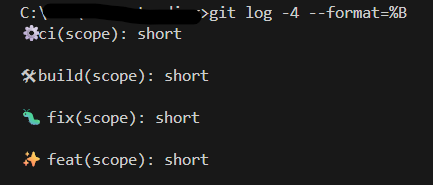Examples
These examples show common usages of how commitlint can be configured.
Validate for issue/ticket numbers
{
// ...
"commitlint": {
"rules": {
"references-empty": [2, "never"],
},
"parserPreset": {
"parserOpts": {
"issuePrefixes": ["PROJ-"],
},
},
},
// ...
}Customizing Emojis and Alignment in VS Code
Some terminals have trouble correctly calculating the width of Unicode emojis, which can cause a missing space after the emoji, leading to misaligned text in the commit prompt.

To fix this issue in VS Code, you can specify an additional space after each emoji in your commitlint.config.ts file.
import { type UserConfig } from "@commitlint/types";
export default {
// Use the conventional commit rules as a base.
extends: ["@commitlint/config-conventional"],
prompt: {
questions: {
type: {
enum: {
// Add a space to a few common types for better alignment.
build: {
emoji: "🛠️ ", // The extra space fixes the alignment.
},
chore: {
emoji: "♻️ ",
},
ci: {
emoji: "⚙️ ",
},
revert: {
emoji: "🗑️ ",
},
},
},
},
},
} satisfies UserConfig;Include Emojis in Commit Messages
By default, emojis are only shown in the commit message prompt. To include them in the actual commit header, you need a custom parser and a setting to enable them.
This configuration is based on the conventional commit rules and uses a parser preset to validate commit headers that start with an emoji.
import type { ParserPreset, UserConfig } from "@commitlint/types";
import config from "@commitlint/config-conventional";
import createPreset from "conventional-changelog-conventionalcommits";
import { merge } from "lodash-es";
// A helper function to create the custom emoji parser preset.
async function createEmojiParser(): Promise<ParserPreset> {
// Generates the regex from the emojis defined in the conventional config.
const emojiRegexPart = Object.values(config.prompt.questions.type.enum)
.map((value) => value.emoji.trim())
.join("|");
const parserOpts = {
// This regular expression validates commit headers with an emoji.
breakingHeaderPattern: new RegExp(
`^(?:${emojiRegexPart})\\s+(\\w*)(?:\\((.*)\\))?!:\\s+(.*)$`,
),
headerPattern: new RegExp(
`^(?:${emojiRegexPart})\\s+(\\w*)(?:\\((.*)\\))?!?:\\s+(.*)$`,
),
};
const emojiParser = merge({}, await createPreset(), {
conventionalChangelog: { parserOpts },
parserOpts,
recommendedBumpOpts: { parserOpts },
});
return emojiParser;
}
const emojiParser = await createEmojiParser();
export default {
extends: ["@commitlint/config-conventional"],
parserPreset: emojiParser,
prompt: {
questions: {
type: {
enum: {
// Customize emojis and add the extra space for better alignment.
build: { emoji: "🛠️ " },
chore: { emoji: "♻️ " },
ci: { emoji: "⚙️ " },
revert: { emoji: "🗑️ " },
},
// This setting includes the emoji in the final commit header.
headerWithEmoji: true,
},
},
},
} satisfies UserConfig;Although some emojis may appear without a trailing space in the terminal, the commit message itself is submitted with the correct formatting.

You can verify this with git log -4 --format=%B > commits.txt.
⚙️ ci(scope): short
🛠 build(scope): short
🐛 fix(scope): short
✨ feat(scope): short